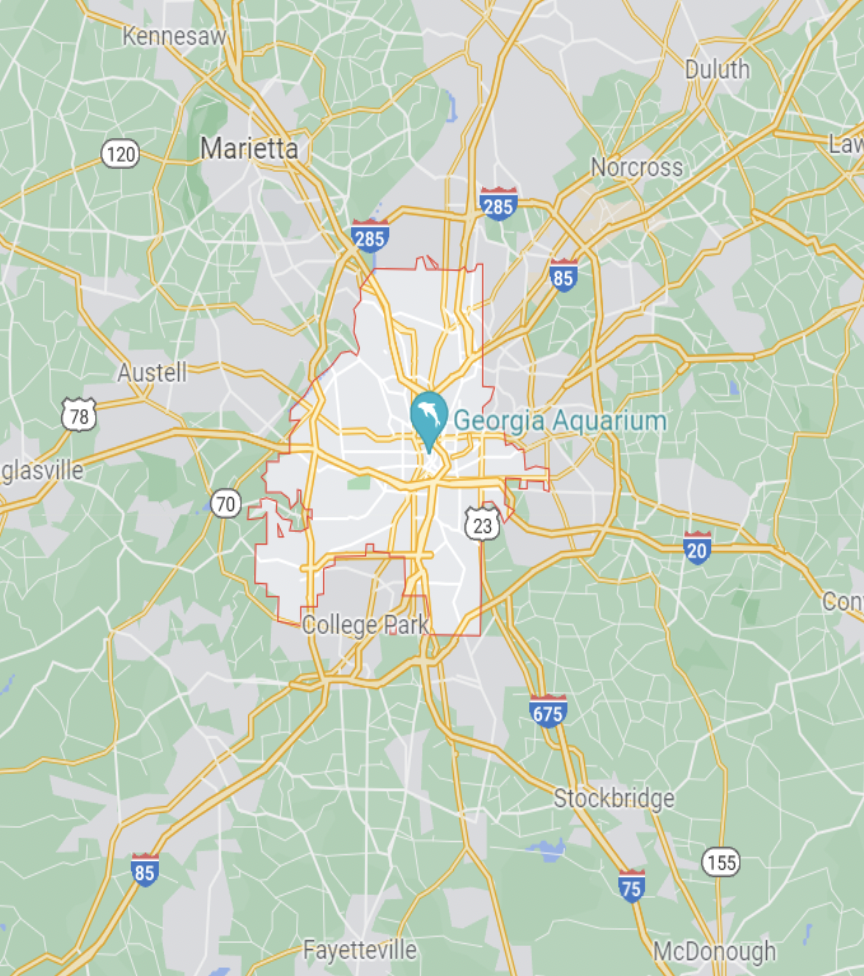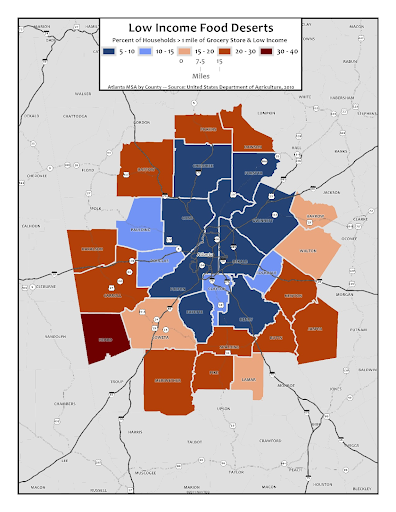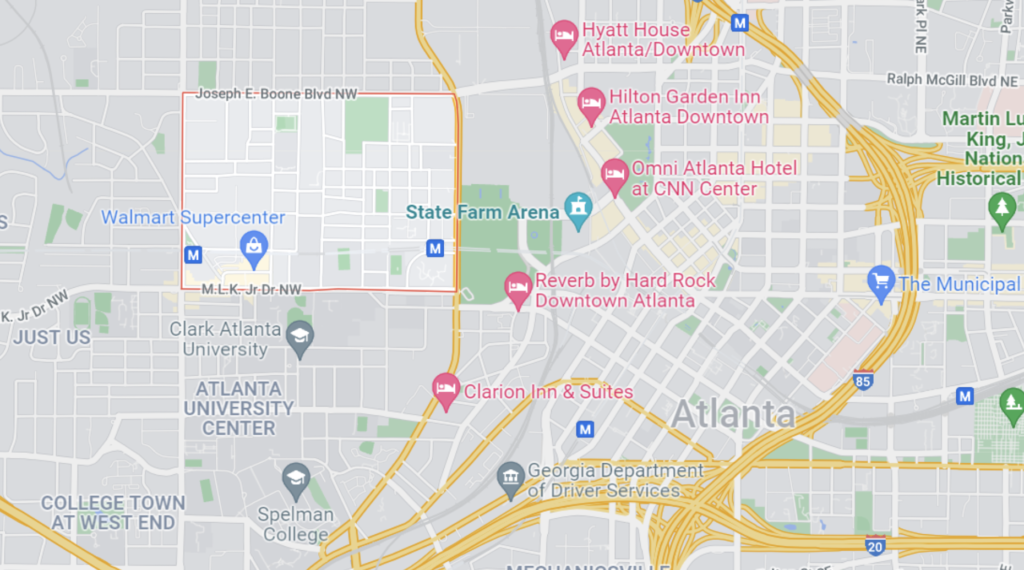What Is A Food Desert?
A food desert is a geographical area where it is difficult to buy healthy, nutritious food at an affordable price. Food deserts include areas where travel to a grocery store is difficult, and in areas where healthy food may be available, but at an unaffordable price.
Atlanta is one of the top ten largest food deserts in the country.
Learn more: What Are Food Deserts?
Fast Facts About Food Deserts in Atlanta
- Almost 2 million people in Georgia live in a food desert, including 500,000 children (Atlanta Journal Constitution).
- There are 35 food deserts in Atlanta according to a 2016 study.
Why Are There Food Deserts In Atlanta?
Food deserts are a socio-economic problem that tend to occur in specific neighborhoods as a result of a lack of proper aid and investment in that neighborhood.
Food deserts are found in Atlanta in neighborhoods with high poverty levels. These areas have lower access to transportation, making it more difficult to get to a grocery store.
Food deserts are also disproportionately found in areas where the residents have lower levels of education and high unemployment rates. Areas with food deserts also have high rates of abandoned or vacant buildings.
Food deserts are more likely to occur in primarily Black communities in Atlanta. A national 2014 study showed that even in areas of equal poverty, Black communities are less likely than communities of other races to have access to grocery stores and fresh food (Bower et al. 2014).
Some scholars in Atlanta refer to food deserts as a modern version of redlining, a discriminatory 1930s practice where primarily Black communities were refused home loans. Historically, supermarkets were built in suburban, White communities. This issue has carried through to today, when grocery stores are less likely to open in areas of low-income and communities of color (Shannon 2018).
Where Are There Food Deserts In Atlanta?
Areas in Atlanta with low-income and low-access to stores, as well as low vehicle access are food deserts.
This map provides an overview of where food deserts are located in the city of Atlanta and surrounding areas. Any area showing green or orange is a food desert. These areas closely overlap with low-income areas.

Source: USDA Food Access Research Atlas
The map below provides a more zoomed-in view of food deserts in Atlanta, defined on this map as places with no vehicles and no nearby grocery stores. Areas in dark red are very far from grocery stores and have very few cars. These areas are food deserts. Source: Metro Atlanta Equity Access


Food deserts may also be defined as areas with no grocery stores nearby where many residents have low incomes. On the map to the right, dark red areas are communities that are far from grocery stores and that are low income. Note that they match up with the areas of low transportation access on the map above.

Solutions
Many solutions have been developed in the Atlanta metro area to address food deserts and food insecurity. While no single solution is effective on its own, a collection of solutions may have some impact on disrupting food deserts and increasing access to healthy food.
Increasing the Number of Grocery Stores & Food Markets
Increasing the number of grocery stores in food deserts will help increase access to healthy food.
While grocery stores may be reluctant to open in low-income neighborhoods, programs exist to try and address this issue. For example, the Healthy Food Financing Initiative offers tax incentives, loans, and grant funding to stores that open in food deserts. They have successfully aided in the opening of several grocery stores.
However, simply increasing the number of grocery stores is not a full solution, as even if grocery stores are accessible, it does not mean that residents can afford the food there. Direct financial assistance to food buyers, rather than (or better yet, in addition to) tax incentives to increase grocery stores.
Another creative solution that increases access to healthy food is fresh food markets at public transit stations on Atlanta’s west side (an area with many food deserts).
These food markets offer healthy food at affordable prices and are located conveniently. They also accept Supplemental Nutrition Assistance Program (SNAP) benefits, making the food much more affordable.
Increased Access To Vehicles And Other Public Transportation Systems
In addition to creating more healthy food options locally, increasing transportation options can help reduce food deserts.
One method to increase transportation to grocery stores is to build up better public transportation. This may include adding a bus stop or even creating a shuttle system within the town.
However, many residents already have access to public transportation, but it is still very inconvenient to take all the way to far away grocery stores.
In 2019, the ride-share service Lyft partnered with Wholesome Wave to offer subsidized rides to grocery stores for families who live in food deserts. While these discounted rides make a big difference, the program is still limited. It has helped 300 families, but the pilot program is only six months long.
Community-Based Solutions: Urban Farming and Food Rescue
A number of startups have sprung up in the Atlanta area that aim to address food insecurity through creative solutions.
Acrefy aims to build community gardens and urban farms in vacant lots in food deserts. Not only will this benefit farmers, as they can grow and sell their produce, but it will also benefit community members by providing healthy food at a cheaper cost.
Another creative community-based solution to food insecurity is the app Goodr, an app that coordinates the donation of food from people in Atlanta with surplus food (for example, from restaurants or grocery stores) to soup kitchens or shelters. The app not only helps increase access to healthy food, but it also reduces food waste.
Other Solutions
Other solutions that could help eliminate food deserts in the city of Atlanta include:
- Financial incentives and support for neighborhood-based grocery stores and farmers markets with discounted prices
- Increased financial assistance for residents of food deserts to buy food
- Restrictions on where dollar stores can be, as they displace grocery stores
- Increased public health education to encourage healthy eating
Some of these solutions are already being implemented.
Case Study: Vine City
Vine City is a neighborhood on Atlanta’s west side. It is often grouped in with the adjacent neighborhood English Avenue.
Vine City is considered a food desert. This is due to low access to transportation, very few grocery stores, and low-incomes. While the area has only a Walmart and a small grocer, Shoppers Supermarket, the area has over 60 convenience stores that do not sell fresh food
Vine City follows the classic characteristics of where food deserts are most commonly found. Compared to the rest of the Atlanta metropolitan area, Vine City has a lower education level, lower income, and a larger non-white community.
- Only 19% of Vine City residents have a Bachelor’s Degree, compared to 51.8% of people in the Atlanta area.
- The median income in Vine City is $30,776 while the median income in the rest of Atlanta is $59,948
- 90% of Vine City residents are Black compared to 51% of the people in Atlanta
Many solutions have been suggested to increase Vine City residents’ access to healthy food.
The biggest solution was the creation of a Walmart in Vine City in 2013. After the chain grocery store Publix moved out in 2009, citing low sales, the area spent four years without a grocery store.
In 2014, a single year after Walmart opened, over 30,000 people shopped at Walmart per week. The majority of products bought there are groceries, and the top sellers are fresh foods.
The Vine City Walmart employs over 200 people, many of whom live in the area.
Another promising solution is the opening of a restaurant, Local Green Atlanta. The restaurant focuses on offering fresh, healthy foods like salads and smoothies at prices the local community can afford. The founder is focused on opening more restaurants in other areas plagued by food deserts.
While these are just two solutions, more work is needed to truly disrupt the food deserts in Vine City and the rest of Atlanta.
